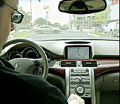
« PREVIOUS ENTRY
Duelling ads

First, we had the problem of people driving while talking on their mobile phones — and distractedly mowing down old ladies like dry grass. So we figured out a solution: Laws that demanded people use hands-free headsets or voice-activated phone dialers.
But as it turns out, not only does this new tech not improve the situation, it might actually make it worse. A recent study by the National Highway Traffic Safety Administration found that people who use hands-free phones are just as likely to plough through grandma and her walker as those who hold the phone in their hands. Indeed, people using hands-free tech made errors in dialing 40 per cent of the time, compared to only 18 per cent of the time when they held the phone; and of course, the more frustrated they are, the more dangerous they are.
As the New York Times reports:
The study concluded that in most cases, drivers “overestimated the ease of use afforded by hands-free phone interfaces.”
Drivers can be easily distracted, even when they have both hands on the wheel. “In many cases, it’s the amount of brain power you’re using,” said David Champion, the senior director of auto tests for Consumer Reports. “Even if you’re using a hands-free phone, you’re using quite a bit of brain power to actually have a discussion.”
Actually, I think they’re doing the wrong research. I don’t think we’ll learn much by comparing the distraction levels of hands-free drivers versus phone-holding ones. Here’s a more interesting research idea: Compare the distraction levels of drivers who are talking on a mobile phone, versus drivers who are talking to someone else in the car.
Why? Because this would clarify what’s really at stake here: The physical context of the person you’re speaking to.
What I mean is this: If I’m driving a car and you’re riding shotgun, we can carry on a conversation, but you’re present in the situation. So if something dangerous is about to happen, you can react. Indeed, since you’re a second pair of eyes, you can actually help me avoid danger — by noticing if I’m driving too fast, or about to rear-end someone because I’m looking off to the side. And since you’re riding in the car, your safety is at risk the same as mine is, so you’ve got a powerful incentive, however subconscious, to monitor the situation and make sure I’m driving reasonably well. Even if the conversation is distracting me, I get some benefit from the person I’m talking to being physically there.
But if I’m talking to you on the phone, I get all the distraction — with none of the help driving. Worse, the conversation is asymmetrical: Whereas I might be only half paying attention because I’m driving, you’re fully engaged in the conversation, and that emotional center of gravity drags me even further away from where I am, which is in a car. In a sense, your physical environment — sitting at home, in a bathtub, in a bar, wherever — infects my environment. That’s why I’d be interested to see data comparing driving quality between a driver who’s talking to a passenger, and a driver who’s talking to someone on the phone.
I suspect we’d find that a driver talking to a passenger performs better. And that would suggest something really cool: That we could make a phone conversation safer by making it more like an in-car conversation.
We could, for example, try to immerse the conversational partner in the driver’s situation — to use telepresence technology to let them virtually “be” in the car. For example, you could be sitting at home talking on the phone to me while I drive, and looking at a screen that shows you a 360-degree view out the windows of my car. You’d be pulled into my situation. And that would probably make you a safer person to have a conversation with. You might well pick up on some dangerous stuff that I’m not seeing.
Of course, this might not work at all. If someone experiences my car ride solely through a screen, it might seem like a video game, and they might actively downplay dangerous driving situations I’m in, because it all seems so unreal.
Either way, the point remains the same. Whenever we talk about how to make a driving conversation safer, all we talk about is modifying the behavior of the person driving. Why not try to modify the behavior of the person on the other end of the line?
I'm Clive Thompson, the author of Smarter Than You Think: How Technology is Changing Our Minds for the Better (Penguin Press). You can order the book now at Amazon, Barnes and Noble, Powells, Indiebound, or through your local bookstore! I'm also a contributing writer for the New York Times Magazine and a columnist for Wired magazine. Email is here or ping me via the antiquated form of AOL IM (pomeranian99).

ECHO
Erik Weissengruber
Vespaboy
Terri Senft
Tom Igoe
El Rey Del Art
Morgan Noel
Maura Johnston
Cori Eckert
Heather Gold
Andrew Hearst
Chris Allbritton
Bret Dawson
Michele Tepper
Sharyn November
Gail Jaitin
Barnaby Marshall
Frankly, I'd Rather Not
The Shifted Librarian
Ryan Bigge
Nick Denton
Howard Sherman's Nuggets
Serial Deviant
Ellen McDermott
Jeff Liu
Marc Kelsey
Chris Shieh
Iron Monkey
Diversions
Rob Toole
Donut Rock City
Ross Judson
Idle Words
J-Walk Blog
The Antic Muse
Tribblescape
Little Things
Jeff Heer
Abstract Dynamics
Snark Market
Plastic Bag
Sensory Impact
Incoming Signals
MemeFirst
MemoryCard
Majikthise
Ludonauts
Boing Boing
Slashdot
Atrios
Smart Mobs
Plastic
Ludology.org
The Feature
Gizmodo
game girl
Mindjack
Techdirt Wireless News
Corante Gaming blog
Corante Social Software blog
ECHO
SciTech Daily
Arts and Letters Daily
Textually.org
BlogPulse
Robots.net
Alan Reiter's Wireless Data Weblog
Brad DeLong
Viral Marketing Blog
Gameblogs
Slashdot Games